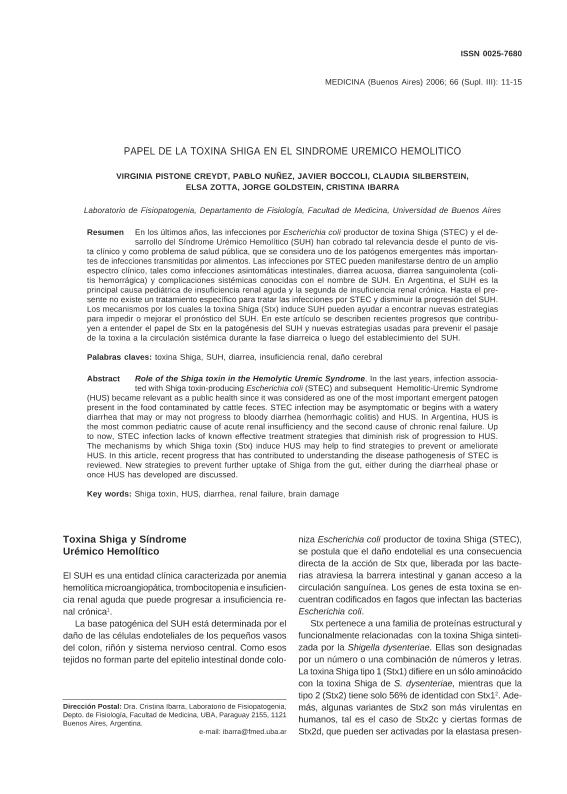Artículo
En los últimos años, las infecciones por Escherichia coli productor de toxina Shiga (STEC) y el desarrollo del Síndrome Urémico Hemolítico (SUH) han cobrado tal relevancia desde el punto de vista clínico y como problema de salud pública, que se considera uno de los patógenos emergentes más importantes de infecciones transmitidas por alimentos. Las infecciones por STEC pueden manifestarse dentro de un amplio espectro clínico, tales como infecciones asintomáticas intestinales, diarrea acuosa, diarrea sanguinolenta (colitis hemorrágica) y complicaciones sistémicas conocidas con el nombre de SUH. En Argentina, el SUH es la principal causa pediátrica de insuficiencia renal aguda y la segunda de insuficiencia renal crónica. Hasta el presente no existe un tratamiento específico para tratar las infecciones por STEC y disminuir la progresión del SUH. Los mecanismos por los cuales la toxina Shiga (Stx) induce SUH pueden ayudar a encontrar nuevas estrategias para impedir o mejorar el pronóstico del SUH. En este artículo se describen recientes progresos que contribuyen a entender el papel de Stx en la patogénesis del SUH y nuevas estrategias usadas para prevenir el pasaje de la toxina a la circulación sistémica durante la fase diarreica o luego del establecimiento del SUH. In the last years, infection associated with Shiga toxin-producing Escherichia coli (STEC) and subsequent Hemolitic-Uremic Syndrome (HUS) became relevant as a public health since it was considered as one of the most important emergent patogen present in the food contaminated by cattle feces. STEC infection may be asymptomatic or begins with a watery diarrhea that may or may not progress to bloody diarrhea (hemorrhagic colitis) and HUS. In Argentina, HUS is the most common pediatric cause of acute renal insufficiency and the second cause of chronic renal failure. Up to now, STEC infection lacks of known effective treatment strategies that diminish risk of progression to HUS. The mechanisms by which Shiga toxin (Stx) induce HUS may help to find strategies to prevent or ameliorate HUS. In this article, recent progress that has contributed to understanding the disease pathogenesis of STEC is reviewed. New strategies to prevent further uptake of Shiga from the gut, either during the diarrheal phase or once HUS has developed are discussed.
Papel de la toxina Shiga en el Síndrome Urémico Hemolítico
Título:
Role of the Shiga toxin in the Hemolytic Uremic Syndrome
Pistone Creydt, Virginia ; Nuñez, Pablo; Boccoli, Javier; Silberstein, Claudia Marcela; Zotta, Elsa; Goldstein, Jorge; Ibarra, Cristina
; Nuñez, Pablo; Boccoli, Javier; Silberstein, Claudia Marcela; Zotta, Elsa; Goldstein, Jorge; Ibarra, Cristina
 ; Nuñez, Pablo; Boccoli, Javier; Silberstein, Claudia Marcela; Zotta, Elsa; Goldstein, Jorge; Ibarra, Cristina
; Nuñez, Pablo; Boccoli, Javier; Silberstein, Claudia Marcela; Zotta, Elsa; Goldstein, Jorge; Ibarra, Cristina
Fecha de publicación:
12/2006
Editorial:
Medicina (Buenos Aires)
Revista:
Medicina (Buenos Aires)
ISSN:
0025-7680
e-ISSN:
1669-9106
Idioma:
Español
Tipo de recurso:
Artículo publicado
Clasificación temática:
Resumen
Palabras clave:
Toxina Shiga
,
Suh
,
Diarrea
,
Insuficiencia Renal
,
Daño Cerebral
,
Shiga Toxin
,
Hus
Archivos asociados
Licencia
Identificadores
Colecciones
Articulos(IBYME)
Articulos de INST.DE BIOLOGIA Y MEDICINA EXPERIMENTAL (I)
Articulos de INST.DE BIOLOGIA Y MEDICINA EXPERIMENTAL (I)
Citación
Pistone Creydt, Virginia; Nuñez, Pablo; Boccoli, Javier; Silberstein, Claudia Marcela; Zotta, Elsa; et al.; Papel de la toxina Shiga en el Síndrome Urémico Hemolítico; Medicina (Buenos Aires); Medicina (Buenos Aires); 66; Supl. III; 12-2006; 11-15
Compartir



